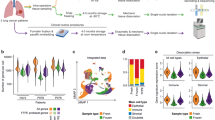Abstract
Targeted cancer therapy directed at individual targets is often accompanied by the rapid development of drug resistance. The development of a new generation of antitumor drugs involves the search for many targets simultaneously to block or, conversely, restore their activity. In this regard, simultaneous analysis of gene expression in a complex network of interactions, primarily cell cycle control elements, is relevant for the search of specific molecular markers for the differential diagnosis of adenocarcinoma (ADC) and squamous cell lung cancer (SCC), as well as new targets for therapy. In this paper we performed an extended quantitative analysis of the expression of two suppressor genes, CTDSPL and its target RB1, as well as 84 genes of the main participants of the p16INK4A-Cdk/cyclin D1-Rb and p53/p21Waf1 signaling pathways in the histological types of non-small-cell lung cancer (NSCLC), i.e., ADC and SCC, using the special panel of the Human Cell Cycle Regulation Panel. The expression profile of some genes shows the specificity to the histological type of NSCLC and the presence of metastases. The genes with a significantly increased expression that affect the activity of Rb (cyclins, cyclin-dependent kinases, their activators, inhibitors, etc.) can serve as potential targets for combined therapy of both ADC and SCC.
Similar content being viewed by others
Abbreviations
- NSCLC:
-
non-small-cell lung cancer
- ADC:
-
adenocarcinoma
- SCC:
-
squamous-cell lung cancer, CTDSPL, C-terminal domain small phosphatase-like protein of the RNA polymerase II
- Rb:
-
retinoblastoma protein
References
Travis W.D., Brambilla E., Noguchi M., et al. 2011. International Association for the Study of Lung Cancer/American Thoracic Society/European Respiratory Society International Multidisciplinary Classification of Lung Adenocarcinoma. J. Thoracic Oncol.: Official Publ. Int. Assoc. Study Lung Cancer. 6, 244–285.
Spiro S.G., Tanner N.T., Silvestri G.A., et al. 2010. Lung cancer: Progress in diagnosis, staging and therapy. Respirology. 15, 44–50.
Gower A., Wang Y., Giaccone G. 2014. Oncogenic drivers, targeted therapies, and acquired resistance in non-small-cell lung cancer. J. Mol. Med. 92, 697–707.
Vincenzi B., Schiavon G., Silletta M., et al. 2006. Cell cycle alterations and lung cancer. Histol. Histopathol. 21, 423–435.
Yokota J., Kohno T. 2004. Molecular footprints of human lung cancer progression. Cancer Sci. 95, 197–204.
Weinberg R.A. 1995. The retinoblastoma protein and cell cycle control. Cell. 81, 323–330.
Osada H., Takahashi T. 2002. Genetic alterations of multiple tumor suppressors and oncogenes in the carcinogenesis and progression of lung cancer. Oncogene. 21, 7421–7434.
Husgafvel-Pursiainen K., Boffetta P., Kannio A., et al. 2000. p53 mutations and exposure to environmental tobacco smoke in a multicenter study on lung cancer. Cancer Res. 60, 2906–2911.
Yeo M., Lin P.S., Dahmus M.E., Gill G.N. 2003. A novel RNA polymerase II C-terminal domain phosphatase that preferentially dephosphorylates serine 5. J. Biol. Chem. 278, 26078–26085.
Kashuba V.I., Li J., Wang F., et al. 2004. RBSP3 (HYA22) is a tumor suppressor gene implicated in major epithelial malignancies. Proc. Natl. Acad. Sci. U. S. A. 101, 4906–4911.
Beniaminov A.D., Krasnov G.S., Dmitriev A.A., Puzanov G.A., Snopok B.A., Senchenko V.N., Kashuba V.I. 2016. Interaction of two tumor suppressor proteins, phosphatase CTDSPL and Rb. Mol. Biol. 50, 438–441.
Travis W.D., Brambilla E., Muller-Hermelink H.K., et al. 2004. World Health Organization Classification of Tumours. Pathology anf Genetics of Tumours of the Lung, Pleura, Thymus and Heart. Lyon: IARC Press.
Minna J., Girard L., Xie Y. 2007. Tumor mRNA expression profiles predict responses to chemotherapy. J. Clin. Oncol. 48, 4329–4336.
Girard L., Rodriguez-Canales J., Minna J.D., et al. 2016. An expression signature as an aid to the histological classification of non-small cell lung cancer. Clin. Cancer Res. 22, 4880–4889.
Russell P.A., Wainer Z., Wright G.M., et al. 2011. Does lung adenocarcinoma subtype predict patient survival?: A clinicopathologic study based on the new International Association for the Study of Lung Cancer/American Thoracic Society/European Respiratory Society International Multidisciplinary Lung Adenocarcinoma Classification. J. Thoracic Oncol: Official Publ. Internat. Assoc. Study Lung Cancer. 6, 1496–1504.
Fischer A.H., Cibas E.S., Howell L.P., et al. 2011. Role of cytology in the management of non-small-cell lung cancer. J. Clin. Oncol: Official J. Am. Soc. Clin. Oncol. 29, 3332–3333.
Di Fiore R., D’Anneo A., Tesoriere G., et al. 2013. RB1 in cancer: Different mechanisms of RB1 inactivation and alterations of pRb pathway in tumorigenesis. J. Cell. Physiol. 228, 1676–1687.
Akli S., Keyomarsi K. 2003. Cyclin E and its low molecular weight forms in human cancer and as targets for cancer therapy. Cancer Biol. Therapy. 2 (4, Suppl. 1), S38–S47.
Komiya T., Hosono Y., Hirashima T., et al. 1997. p21 expression as a predictor for favorable prognosis in squamous cell carcinoma of the lung. Clin. Cancer. Res. 3, 1831–1835.
Zhu Y., Lu Y., Zhang Q., et al. 2012. MicroRNA-26a/b and their host genes cooperate to inhibit the G1/S transition by activating the pRb protein. Nucleic Acids Res. 40, 4615–4625.
Author information
Authors and Affiliations
Corresponding author
Additional information
Original Russian Text © G.S. Krasnov, G.A. Puzanov, A.V. Kudryavtseva, A.A. Dmitriev, A.D. Beniaminov, T.T. Kondratieva, V.N. Senchenko, 2017, published in Molekulyarnaya Biologiya, 2017, Vol. 51, No. 5, pp. 849–856.
Rights and permissions
About this article
Cite this article
Krasnov, G.S., Puzanov, G.A., Kudryavtseva, A.V. et al. Differential expression of an ensemble of the key genes involved in cell-cycle regulation in lung cancer. Mol Biol 51, 740–747 (2017). https://doi.org/10.1134/S0026893317050107
Received:
Accepted:
Published:
Issue Date:
DOI: https://doi.org/10.1134/S0026893317050107




